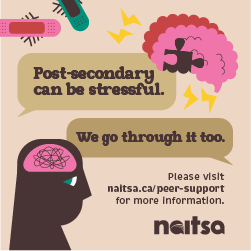Price, schedule and educational goals and experiences are often the greatest factors in how a student chooses an academic upgrading system.
Alberta is unique in that students are offered a variety of options for academic upgrading. Norquest College, distance learning like the Alberta Distance Learning Centre (ADLC) or outreach programs like Inner City High School in Edmonton are all ways that students can gain a high school diploma. NAIT differs by offering equivalency programs.
How d o e s NAI T ’s Academic Upgrading program stack up against various other methods of upgrading in Alberta, like ADLC?
The costs of each program can be difficult to directly compare as most programs offer different incentives to students who wish to upgrade.
NAIT estimates a cost of about $600 per semester, which includes tuition, books and mandatory fees (NAITSA, U-Pass, health and dental and recreation and athletics). This is for a single course that can give a student a high school equivalency grade but not credits towards a high school diploma.
A course at ADLC averages around $850 for the print and $700 for the online version. These prices include tuition, textbooks and materials. Credits earned can be used for gaining a high school diploma. Individuals 19 and under, as of Sept. 1 of the school year are eligible to receive free academic upgrading at ADLC.
Prices for upgrading in other systems in the province are comparable across the board. Financial support is offered through many Alberta programs for students looking to upgrade.
If students wish to work day jobs, it could be made tricky by NAIT’s upgrading class schedule. Tira Shaw, a student upgrading through NAIT, says students can expect to spend around “ … four to six hours in a class most days.”
Nicole Denis, a NAIT business student, does her upgrading at ADLC instead of NAIT because of scheduling issues.
“You can’t be entered in two programs [at NAIT] … for people like me who are only taking two classes, it doesn’t make much sense,” said Denis. She believes ADLC is better for her work schedule as it allows her to work full-time and gives her a year, instead of a semester, to complete her coursework.
Both Shaw and Denis have experiences with NAIT and ADLC, allowing them to compare programs.
Academic Goals/Overall Experience:
As mentioned, ADLC offers courses that are applicable towards a high school diploma, while NAIT offers equivalency courses that are recognized at all post-secondary institutions in Alberta.
Both NAIT and ADLC’s programs focus on allowing students to take high school courses they have not been enrolled in or to improve their grade in a course they have already taken.
NAIT’s main objective is to provide students the prerequisites to enter other programs at its institution. “[Students] are looking to either gain entrance requirements needed for a career program … or they are looking to get a better mark to be more competitive in their career-program application,” said Shelley Kolodzinski, portfolio manager for NAIT Academic Upgrading.
“The added value is our instructors are also teaching these courses in the career programs,” said Kolodzinski.
The face-to-face interaction between instructors and students is also an advantage NAIT has over programs like ADLC. “I tried doing correspondence but I didn’t really have the motivation … I also needed more time because … the closest place I could interact with a teacher was an hour away. It’s easier to learn here … they [NAIT instructors] are more into the course,” said Shaw.
On the other end of the spectrum, Denis actively chose ADLC to avoid the classroom setting and to complete coursework on her own schedule. “They had online courses … therefore I could do it at my own pace rather than attending a classroom every day,” said Denis.
As Denis does not aim to pursue another program at NAIT, ADLC’s upgrading system seems to work best for individuals looking to gain high school grades but want to remain open to broader post-secondary opportunities. ADLC also offers every high school course available in Alberta, while NAIT focuses on courses that are applicable to its own programs.
– Jory Proft






